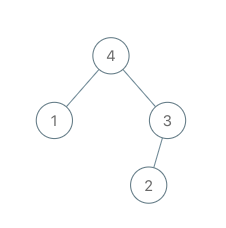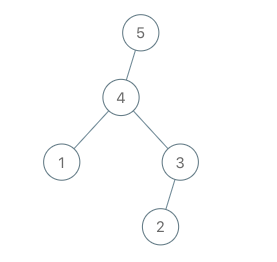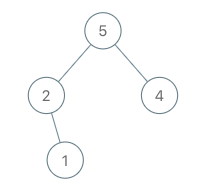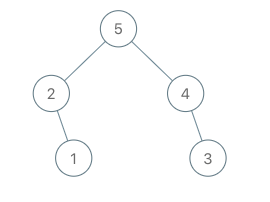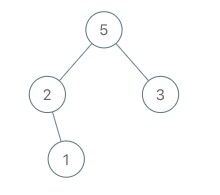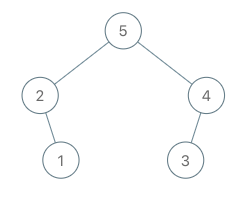We are given the root node of a maximum tree: a tree where every node has a value greater than any other value in its subtree.
Just as in the previous problem, the given tree was constructed from an list A (root = Construct(A)) recursively with the following Construct(A) routine:
- If
Ais empty, returnnull. - Otherwise, let
A[i]be the largest element ofA. Create arootnode with valueA[i]. - The left child of
rootwill beConstruct([A[0], A[1], ..., A[i-1]]) - The right child of
rootwill beConstruct([A[i+1], A[i+2], ..., A[A.length - 1]]) - Return
root.
Note that we were not given A directly, only a root node root = Construct(A).
Suppose B is a copy of A with the value val appended to it. It is guaranteed that B has unique values.
Return Construct(B).
Example 1:
Input: root = [4,1,3,null,null,2], val = 5 Output: [5,4,null,1,3,null,null,2] Explanation: A = [1,4,2,3], B = [1,4,2,3,5]
Example 2:
Input: root = [5,2,4,null,1], val = 3 Output: [5,2,4,null,1,null,3] Explanation: A = [2,1,5,4], B = [2,1,5,4,3]
Example 3:
Input: root = [5,2,3,null,1], val = 4 Output: [5,2,4,null,1,3] Explanation: A = [2,1,5,3], B = [2,1,5,3,4]
Constraints:
1 <= B.length <= 100
# Definition for a binary tree node.
# class TreeNode:
# def __init__(self, val=0, left=None, right=None):
# self.val = val
# self.left = left
# self.right = right
class Solution:
def insertIntoMaxTree(self, root: TreeNode, val: int) -> TreeNode:
if root is None or root.val < val:
return TreeNode(val, root, None)
root.right = self.insertIntoMaxTree(root.right, val)
return root/**
* Definition for a binary tree node.
* public class TreeNode {
* int val;
* TreeNode left;
* TreeNode right;
* TreeNode() {}
* TreeNode(int val) { this.val = val; }
* TreeNode(int val, TreeNode left, TreeNode right) {
* this.val = val;
* this.left = left;
* this.right = right;
* }
* }
*/
class Solution {
public TreeNode insertIntoMaxTree(TreeNode root, int val) {
if (root == null || root.val < val) {
return new TreeNode(val, root, null);
}
root.right = insertIntoMaxTree(root.right, val);
return root;
}
}/**
* Definition for a binary tree node.
* class TreeNode {
* val: number
* left: TreeNode | null
* right: TreeNode | null
* constructor(val?: number, left?: TreeNode | null, right?: TreeNode | null) {
* this.val = (val===undefined ? 0 : val)
* this.left = (left===undefined ? null : left)
* this.right = (right===undefined ? null : right)
* }
* }
*/
function insertIntoMaxTree(
root: TreeNode | null,
val: number
): TreeNode | null {
if (root == null || val > root.val) {
return new TreeNode(val, root);
}
root.right = insertIntoMaxTree(root.right, val);
return root;
}/**
* Definition for a binary tree node.
* struct TreeNode {
* int val;
* TreeNode *left;
* TreeNode *right;
* TreeNode() : val(0), left(nullptr), right(nullptr) {}
* TreeNode(int x) : val(x), left(nullptr), right(nullptr) {}
* TreeNode(int x, TreeNode *left, TreeNode *right) : val(x), left(left), right(right) {}
* };
*/
class Solution {
public:
TreeNode* insertIntoMaxTree(TreeNode* root, int val) {
if (root == nullptr || root->val < val) {
return new TreeNode(val, root, nullptr);
}
root->right = insertIntoMaxTree(root->right, val);
return root;
}
};/**
* Definition for a binary tree node.
* type TreeNode struct {
* Val int
* Left *TreeNode
* Right *TreeNode
* }
*/
func insertIntoMaxTree(root *TreeNode, val int) *TreeNode {
if root == nil || root.Val < val {
return &TreeNode{
Val: val,
Left: root,
Right: nil,
}
}
root.Right = insertIntoMaxTree(root.Right, val)
return root
}
